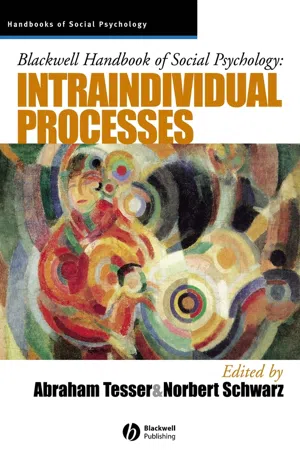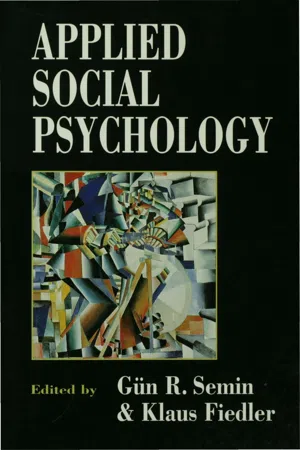Psychology
Attitude
Attitude refers to a person's evaluation or feeling toward a particular object, person, event, or idea. It encompasses beliefs, emotions, and behaviors and can be positive, negative, or neutral. Attitudes can influence how individuals perceive and interact with the world around them, shaping their thoughts, decisions, and actions.
Written by Perlego with AI-assistance
Related key terms
1 of 5
12 Key excerpts on "Attitude"
- eBook - ePub
Attitudes Toward Handicapped Students
Professional, Peer, and Parent Reactions
- Marcia D. Horne(Author)
- 2012(Publication Date)
- Routledge(Publisher)
1 The Concept of Attitude: Definition and Theory The purpose of this chapter is to review the concept of Attitude. After presenting some introductory information about the concept of Attitude, the chapter overviews representative theories.There are many theories of Attitude; the ones included in this chapter were chosen because they were considered to have significantly impacted upon contemporary Attitude theory and at the same time are representative of different theoretical perspectives.Introduction to AttitudesThis section opens with a presentation of different definitions of the concept of Attitude which have been presented in the literature. This is followed by a discussion of components of an Attitude, the relationships between Attitudes and behavior, and the possible functions Attitudes may serve.Definition of Attitude Many researchers have offered definitions of Attitude. A sample of these illustrates similarities and differences in conceptualizations.An Attitude is a mental and neural state of readiness, organized through experience, exerting a directive or dynamic influence upon the individual’ s response to all objects and situations with which it is related (Allport, 1935).A social Attitude... may be defined as a set of evaluative categorizations formed toward an object or class of objects as the individual learns, in interaction with others, about his environment including evaluations of other persons. Through Attitude formation, the individual relates himself, psychologically, to these objects. His Attitudes become constituent parts of his self (ego) system. By definition, therefore, Attitudes have emotional and motivational aspects inseparably intertwined with cognitive content (Sherif, Sherif & Nebergall, 1965, p. 20).An Attitude is a tendency to act toward or against some environmental factor which becomes thereby a positive or negative value (Bogardus, 1931, p. 52). - eBook - PDF
Blackwell Handbook of Social Psychology
Intraindividual Processes
- Abraham Tesser, Norbert Schwarz, Abraham Tesser, Norbert Schwarz(Authors)
- 2008(Publication Date)
- Wiley-Blackwell(Publisher)
As one may expect of any concept that has received decades of attention, the concept of Attitudes has changed over the years (see Allport, 1954, for an early review). The initial definitions were broad and encompassed cognitive, affective, motivational, and behavioral components. For example, Allport (1935) defined an Attitude as “a mental and neural state of readiness, organized through experience, exerting a directive and dynamic influence upon the individual’s response to all objects and situations with which it is re-lated” (ibid., p. 810). A decade later, Krech & Crutchfield (1948) wrote, “An Attitude can be defined as an enduring organization of motivational, emotional, perceptual, and cogni-tive processes with respect to some aspect of the individual’s world” (ibid., p. 152). These definitions emphasized the enduring nature of Attitudes and their close relationship to individuals’ behavior. Some sociologists (e.g. Fuson, 1942) and psychologists (e.g. Campbell, 1950) even defined Attitudes simply in terms of the probability that a person will show a specified behavior in a specified situation. In subsequent decades, the Attitude concept lost much of its breadth and was largely reduced to its evaluative component. In the succinct words of Daryl Bem, “Attitudes are likes and dislikes” (Bem, 1970, p. 14). Similarly, Eagly & Chaiken (1993), in a highly influential textbook, defined Attitudes as “a psychological tendency that is expressed by evaluating a particular entity with some degree of favor or disfavor” (ibid., p. 1). Along the way, many functions that were initially ascribed to Attitudes have been reassigned to other cognitive structures and the accumulating body of empirical findings drew many of the classic assumptions into question. A growing body of literature suggests that Attitudes may be much less enduring and stable than has traditionally been assumed. As we review below, self-reports of Attitudes are - eBook - PDF
- Ulrich Ammon, Norbert Dittmar, Klaus J. Mattheier, Peter Trudgill, Ulrich Ammon, Norbert Dittmar, Klaus J. Mattheier, Peter Trudgill(Authors)
- 2020(Publication Date)
- De Gruyter Mouton(Publisher)
'Attitude' is derived from two roots: from the late Latin word 'aptitudo', meaning readiness, inclina-tion, and — via the Italian 'atto' — from the Latin 'actus', meaning action, behaviour. Hence, Attitude has a lot to do with behav-iour, but it is not behaviour; Attitude means readiness to behaviour. Fishbein and Ajzen (1975, 6) define 'Attitude' as a predisposition to respond in a consistently favourable or unfavourable manner with respect to a given object — this object may be a person, a group, an event, a situation, a fact, a language variety, a linguistic variant etc. A first impor-tant implication of this definition is that an Attitude as such is not directly perceivable or measurable. It is a mental and neural state of readiness (Allport 1954, 24), a hypothetical construct which mediates between stimulus and response. However, hypothetical does not mean empty or vague. On the contrary, the definition implies both structure and quality. Regarding structure, the presence of a number of components is assumed; as to quality, consistency is the central criterion. 3. Structure The construct of Attitude is often thought to consist of three components, a cognitive one, an evaluative one and a conative one. The reasoning is that before somebody can react consistently to an object, he first has to know something about it. Only then can he evaluate the object positively or negatively. Finally, this knowledge and these feelings are accom-panied by behavioural intentions. 3.1. The Cognitive Component The cognitive component of the Attitude in-cludes all kinds of knowledge one has about the Attitude object. This knowledge is com-posed of so-called beliefs. Beliefs are the smallest cognitive units of the conceptual structure. Fishbein and Ajzen (1975, 131) de-fine them as a person's subjective probabi-lity judgments concerning some discriminable aspect of his world. - eBook - PDF
The Psychology of Influence
Theory, research and practice
- Joop van der Pligt, Michael Vliek(Authors)
- 2016(Publication Date)
- Routledge(Publisher)
In everyday speech, we talk about ‘opinions’, ‘feelings’, ‘preferences’ and ‘convictions’. All these are evaluative responses that fall under the generic heading ‘Attitude’. To put it another way, Attitudes refer to people’s evaluative responses – positive or negative – to a stimulus, the so-called Attitude object. An Attitude object can be a person (a politician, your landlord, yourself), an organisation (the tax authority, social services) or a situation (a party, a lesson at school), but also a product (food, cosmetics) or an idea (halting immigration, raising the motorway speed limit). Defined in this way, it seems logical that Attitudes directly relate to behaviour: people in 18 Attitudes and behaviour the UK with a positive Attitude towards the Conservative Party and a negative Attitude towards Labour are more likely to vote Conservative, right? Even though the answer is quite likely yes, it isn’t as straightforward as it seems, which is why the study of Attitudes and Attitude change has one of the longest histories in social psychology (for a review, see Briñol & Petty, 2012). Indeed, one of the founders of social psychology, Gordon Allport (1935), went so far as to call Attitudes the single most indispensable concept in the field. The origins of research in this field date back to the 1920s and 1930s, and in its early days it was concerned primarily with Attitude measurement (Bogardus, 1925; Thurstone & Chave, 1929; Likert, 1932), with the initial discussion revolving around whether or not they are actually measurable (Thurstone’s famous article of 1928 is entitled ‘Attitudes can be measured’). There was also interest in how Attitudes affect behaviour, with LaPiere (1934) providing a classic example. In an era in which negative racial stereotypes about Chinese people were prevalent, he visited a number of restaurants in the southern United States in the company of a Chinese man and woman. - Available until 25 Jan |Learn more
- Bob M. Fennis, Wolfgang Stroebe, Bob M Fennis(Authors)
- 2020(Publication Date)
- Routledge(Publisher)
Finally, Attitudes can be based on behavioural information. For example, people sometimes infer their Attitudes from their past behaviour towards the Attitude object. This assumption was central to Bem’s (1965, 1972) self-perception theory. He argued that people rarely have direct, privileged information about their Attitudes and therefore often have to infer them from their own behaviour. Thus, if one were asked whether one liked Coca-Cola, one might infer one’s brand Attitude from the frequency with which one has recently drunk it (‘I drink it a lot, therefore I must like it’). What then are the areas of disagreement regarding the definition of Attitude? Since this is not the place to enter into a discussion of the finer points of this controversy, we will highlight only the two major points of contention, namely (a) whether Attitudes should be defined as a predisposition to evaluate an Attitude object in a particular way or as the evaluative response itself and (b) whether Attitudes are stable or context dependent. Let us illustrate these points by presenting what is still the most influential definition of Attitudes, namely that ‘Attitude is a psychological tendency that is expressed by evaluating a particular entity with some degree of favour or disfavour’ (Eagly & Chaiken, 1993, p. 1). Eagly and Chaiken (1993, 2007) postulate that this predisposition to evaluate is expressed by three types of evaluative responses, namely cognitive, affective or behavioural. Cognitive evaluative responses consist of the beliefs people hold about the Attitude object. These beliefs reflect the connection people see between the Attitude object and various evaluative attributes. Cognitive evaluative responses can range from extremely positive to extremely negative - eBook - PDF
Galician and Irish in the European Context
Attitudes Towards Weak and Strong Minority Languages
- B. O'Rourke(Author)
- 2010(Publication Date)
- Palgrave Macmillan(Publisher)
However, despite its popularity, even within the core discipline of social psychology, there is no general agreement on its definition. An examination of any text of social psychology demon- strates this (Edwards 1982: 20). Among the countless definitions which have been formulated, one of the most widely used is that offered by Fishbein and Ajzen (1975: 6). They define Attitude as a learned predispo- sition to respond in a consistently favourable or unfavourable manner with respect to a given object. In the case of language Attitudes, which concern us here, the ‘object’ towards which such predispositions are held is of course language. According to Fishbein and Ajzen’s (ibid.) definition, an Attitude is ‘learned’ through a socialization process which begins in early child- hood and, as Allport’s (1935) definition highlights, is ‘organised through experience’ within the social world. Attitudes are not fixed but are instead constantly fluctuating and shifting according to their social environment. Fishbein and Ajzen’s (1975) definition, like that proposed by Allport (1935), reflects the mentalist perspective within Attitude studies in which an Attitude is viewed as ‘an internal state aroused by stimulation of some type and which may mediate the organism’s subsequent response’ (see Williams 1974: 21). According to the mentalist perspective, an Attitude is a deep-seated and private ‘state of readiness rather than an observ- able response’ (Fasold 1984: 147). In contrast to this is the behaviour- ist perspective which views Attitudes as overt and observable responses to social situations, thereby essentially by-passing Attitudes per se and concentrating directly on expressed behaviour (see McGuire 1969). However, as Agheyisi and Fishman (1970) have pointed out, resorting solely to the behaviourist model makes Attitude a dependent variable and 8 Galician and Irish in the European Context as such it loses its capacity to account for and explain social behaviour. - eBook - PDF
- Gün R Semin, Klaus Fiedler, Gün R Semin, Klaus Fiedler(Authors)
- 1996(Publication Date)
- SAGE Publications Ltd(Publisher)
'Entity ' here means the object of an Attitude, and can include individuals, inanimate objects, concepts, social groups, nations, social policies, behaviours, and so on; in fact anything to which one can respond favourably or unfavourably. 4 General Framewo rks in Applied Social Psychology Table 1 . 1 Dif ferent types of evaluative response Response mode Verbal Nonverbal Affect Expressions of feelings towards at ti tude object Physiological responses to Attitude object Source: after Ajzen (1 988) Response category Cognition Expressions of beliefs about at ti tude object Perceptual responses (e.g. reaction time) to at ti tude object Behaviour Expressions of behavioural inten tions towards Attitude object Overt behavioural responses to atti tude object For the sake of clarity, the term 'Attitude object' will be used in the rest of this chapter to refer to this large class of people and things towards which we can hold Attitudes. Eagly and Chaiken's definition of Attitudes immediately raises the issue of the relationship between Attitudes and behaviours, since 'behavioural responses' are listed as one of the ways in which an individual can express his or her evaluation of the Attitude object. How, you might wonder, can we speak about an 'Attitude-behaviour relationship' if behaviour is a component of Attitude? In order to clarify this issue we need to examine the concept of Attitude a little more closely. An Attitude is, of course, a hypothetical con-struct, in the sense that we cannot directly sense or measure it. Its existence is inferred from certain classes of evaluative responses to the Attitude object. If someone persistently expressed the view that members of a particular race are unintelligent, we would probably infer that this person has a prejudiced Attitude towards members of that race. Likewise, if someone attended a football match every single weekend during the football season, we might infer that he has a positive Attitude to football. - eBook - PDF
- John Edwards(Author)
- 2011(Publication Date)
- Palgrave Macmillan(Publisher)
The difficulty is leakage. Researchers may con- struct tight definitional containers, but faithful adherence has proved difficult: the attractiveness of more fluid connotations tends always to seep in. Indeed, scholars may sometimes want to depart from their own containerisation, and use terms in their ‘street’ sense. Social science has generally considered ‘Attitude’ as a disposition to react favourably or unfavourably to a class of people, events, objects and so on. As noted above, the concept is defined to have three elements: thoughts or beliefs (the cognitive component), feelings (the ‘affective’ component) and predispositions to act in a certain way (the behavioural aspect). That is, one knows or believes something, has some emotional reaction to it and, therefore, may be assumed to act on this basis. Quite apart, however, from the leakage or spillage mentioned above, there at least two other important difficulties to be taken into account. The first, as we have seen, has to do with the very frequent inconsistency between assessed Attitudes and actions presumably related to, or based upon, them. The second is that there often exists a disjunction between Attitude and belief. Confusion between belief and Attitude shows up clearly on question- naires and interviews designed to tap the latter. In scholarly usage, as just noted, Attitude includes belief as one of its components. Thus, a par- ent’s response to a questionnaire item like ‘Is a knowledge of French important for your children?’ – where the response is to be of the ‘yes- or-no’ variety or, more commonly, made along a continuum anchored at one end by ‘strongly agree’ and, at the other, by ‘strongly disagree’ (or something similar) – indicates a belief. To gauge Attitude would require further probing into the respondent’s feeling about this expressed belief, would require adding the affective component to the cognitive one. Without this further enquiry, we cannot really say we have come to - eBook - PDF
The SAGE Handbook of Social Psychology
Concise Student Edition
- Michael A Hogg, Joel Cooper, Michael A Hogg, Joel Cooper(Authors)
- 2007(Publication Date)
- SAGE Publications Ltd(Publisher)
It is difficult to imagine a psychological world with-out Attitudes. One would go about daily life without the ability to think in terms of ‘good’ and ‘bad’, ‘desirable’ and ‘undesirable’, or ‘approach’ and ‘avoid’. There would be no activation of positivity or approach tendencies upon encounter-ing objects that would engender positive outcomes, but, perhaps more seriously, there would also be no mental faculty for avoiding negative objects in one’s environment. Our environment would make little sense to us; the world would be a cacophony of meaningless blessings and curses. Existence would be truly chaotic, and probably quite short. For these reasons, the Attitude construct has proven indispensable in social psychology’s under-standing of why we think, feel, and do the things we do. Indeed, the field of social psychology was once defined as the study of Attitudes (Thomas and Znaniecki, 1918). Even a quick perusal of the various books and review chapters on the Attitude construct reveals that virtually everyone begins with broad assertions about how pervasive evalu-ation is in everyday life (e.g., Fazio, 2001; Petty and Cacioppo, 1981). Osgood et al. (1957) showed that most of the meaning in language comes from eval-uation. Certainly, Attitudes have occupied a central position in social psychology for decades (Allport, 1935; Doob, 1947; McGuire, 1985). How do we come to evaluate objects in our environment as positive or negative? What are the functions of these evaluations? How are they represented in memory, and how does this repre-sentation affect the ways they operate in predicting behavior? History has proven these questions to be some of the most important, and challenging, of social psychology. Our goal in this chapter is to describe some of the ways in which researchers have approached these questions about the nature of Attitudes and to relate some of the insights that the field has collected in nearly 100 years. - Marlis Hellinger, Anne Pauwels, Marlis Hellinger, Anne Pauwels(Authors)
- 2008(Publication Date)
- De Gruyter Mouton(Publisher)
The extent to which a person may alter his or her Attitude towards an object is made up of many parts: Indi-viduals may alter their beliefs, feelings, approval, action-orientation, or behav-iour towards an object (see Robinson 2003: 136). These parts are inter-related, but each is subtly different from the others. Thus, we may have negative feel-ings about people who have a particular accent (for example, RP in English) and we may believe that such people are untrustworthy and to this end reduce con-tact with them. If we have extensive contact with a particular RP speaker, we may develop positive feelings towards this person, but this may not change our negative affect towards the Attitude object (speakers of RP as a group) – the en-during nature of the Attitude is maintained. Indeed, the stability of Attitudes in the face of contrary cases like the example above is one of their most interesting features to social psychologists. Attitudes to language and communication 597 Thus, while beliefs are a core part of Attitude, the latter is constituted of more than beliefs. As a result, much attention has been paid by social psycho-logists to understanding the relationship (often imperfect, to say the least) be-tween Attitudes and behaviour, and also to examining the emotional part of atti-tudes. There is a large literature on the impact of mood and emotion on beliefs and social judgements, and the resultant impact on behaviour (this area often goes by the name of hot cognition , cf. Forgas 2000). Within language and social psychology, the centrality of Attitude to the research approach has had a number of theoretical and methodological consequences, which set this tradition apart from other approaches to language and communication.- James T. Tedeschi(Author)
- 2013(Publication Date)
- Academic Press(Publisher)
ISBN: 0-12-685180-8 108 Jerald M. Jellison Traditional Conception of Internalized Attitudes The concept of Attitude has a long and varied history (cf. Fleming, 1967), but by the 1950s there was a general consensus about the definition and conception of Attitude. Attitude was typically defined as a learned predisposition to respond favorably or unfavorably to a class of objects. Implicit in the definition was the assumption that an Attitude was endur-ing and would produce consistency in the individual's response to the at-titude object across time and situations. A common model of Attitude assumed a cognitive component based on information or rational argu-ments, from which the evaluative or affective component was derived, and which led to the behavioral· component and the associated overt ac-tions (Krech, Crutchfield, & Ballachey, 1962). This tripartite distinction (i.e., cognition, affect, behavior) presents a rational and linear sequence from internal beliefs and attitydes to overt behavior. Conceptions such as these dominated the field of social psychology in the midtwentieth cen-tury and produced a wide variety of research. The primary research thrust concerned theoretical rather than practi-cal questions and was carried out by a group of researchers at Yale University (Hovland, Janis, & Kelley, 1953). This research examined fac-tors that could effect change in the evaluative component, which became synonymous with the concept of Attitude. Scores of studies were con-ducted and involved manipulations of the amount, kind, and source of in-formation to which an individual was exposed and the effect on Attitude change (McGuire, 1969). On the whole this research provided evidence that changes in the cognitive component could affect the evaluative or at-titudinal component. Research on the causal relationship between the evaluative compo-nent and the behavioral component was far less common and far less sup-portive.- eBook - PDF
- Anthony G. Greenwald, Timothy C. Brock, Thomas M. Ostrom, Anthony G. Greenwald, Timothy C. Brock, Thomas M. Ostrom(Authors)
- 2013(Publication Date)
- Academic Press(Publisher)
Attitude is not an automatic reflex or immutable disposition, but rather it exists in a personal and situational context. Attitudes, for Lewin, were represented in the individual's life space and imbedded in a cognitive context, with affective and cognitive structures operating in an interdependent fashion to determine subsequent behavior. It was this field-theoretic orientation of Lewin's that set the stage for the subsequent develop-ment of the cognitive balance interpretations of Attitude change. Modern analyses of cognitive integration (e.g., Abelson, Aronson, McGuire, Newcomb, Rosenberg, & Tannenbaum, 1968; Feldman, 1966; Osgood, 1960; Rokeach & Rothman, 1965) have built upon Lewin's conception of life space as a dynamic system of regions and forces. It is clear that his insightful analysis of behavioral conflicts (approach-approach, approach-avoidance, avoidance-avoidance) has a direct analog in contemporary theories of affective and belief con-sistency (Abelson & Rosenberg, 1958; Heider, 1958) and their rela-tion to behavior (Insko & Schopler, 1967; Rosenberg & Hovland, 1960). Finally, the study of cognitive complexity draws many of its theoretical concepts from Lewin's structural analysis of life space (Brock, 1962; Crockett, 1965; Harvey, 1967; Kerlinger, 1967; Schroder, Driver, & Streufert, 1967; Scott, 1963; Zajonc, 1960). THOMAS M. OSTROM 13 NEWCOMB Newcomb's early work with Attitudes (1943) emphasized the impor-tance of the interpersonal context in maintaining and changing atti-tudes. Newcomb found, in his now classical Bennington study, that to the extent individuals continued to interact with those friendship, parental, and peer groups within which they formed their Attitudes, the acquisition of new information had little effect on those Attitudes.
Index pages curate the most relevant extracts from our library of academic textbooks. They’ve been created using an in-house natural language model (NLM), each adding context and meaning to key research topics.











